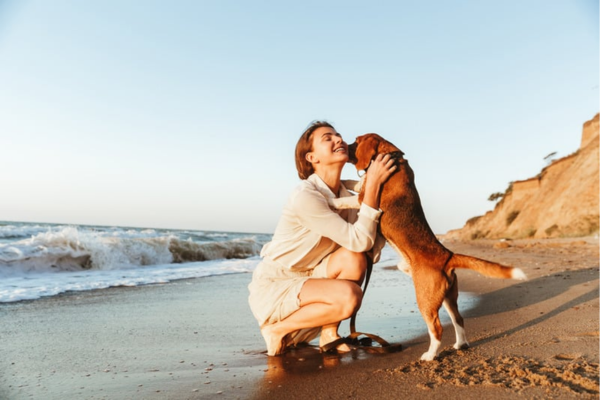Lately, more people have wanted to travel with their pets. This trend is especially popular with service dog handlers who count on their dogs to help them enjoy their vacations. Their service dogs help them get around and ensure they’re safe in unfamiliar areas.
However, traveling with a service dog can be challenging. You must adhere to travel rules and regulations while ensuring your pet doesn’t get overly anxious during travel. However, if you know the requirements, you will have a successful trip.
This article will provide service dog travel guidelines to ensure you have a great vacation.
Pre-Trip Preparations
Health Check and Documentation
Certain types of service dog documentation may be necessary when you travel. Many airlines require vaccination records and health certificates for all pets that fly internationally, and the country you are traveling to may also require them upon your arrival.
Some destinations within the U.S. will also require a health certificate. The certificate should list:
- Your name, phone number, and address
- Your dog’s breed, sex, age, color, and markings
- A list of vaccines, including the date and expiration date.
Understanding Destination Regulations
Regulations differ from destination to destination. Some countries, states, and airlines may insist that you have service dog documentation when you depart and arrive, while others may not.
Research service dog travel laws and regulations at your destination and departure city. If you are unsure, contact the embassy or local authorities for specific requirements.
Packing Essentials
Several essentials will ensure your dog is well cared for throughout the trip. Consider preparing a pet suitcase for all your service dog’s travel needs. The suitcase may include the following items.
- Food: If you prefer to travel light, bring just a few dog food cans and buy more at your destination. However, you should have enough to get through the first leg of your trip and feed your dog when you arrive. Airlines will allow you to bring wet, dry, and dehydrated food on a plane. However, wet and dry dog food are considered solid food items, and you may need to separate them from your luggage during security screenings.
- Medications: If your dog requires medication, you must take it to ensure they don’t get sick on the trip. Medication is allowed on planes, and there are no limitations regarding how much you can bring. However, liquid medications must be stored in containers 3.4 ounces or smaller.
- Toys: Toys may help reduce your dog’s anxiety when you’re away from home. Pack a couple of their favorite toys in your luggage.
- Grooming Equipment: Dogs have different grooming needs depending on their breed. If you only plan to be away for a week, you may not require more than a brush. If you take a longer trip, consider bringing a toothbrush, nail clippers, and other grooming instruments.
- ID Tags: It would be heartbreaking to lose your service dog, especially in a strange city or country. ID tags increase the chance they will be located if they run off. Have your dog wear them throughout your vacation to ensure safety.
Make a service dog packing list to ensure you don’t forget anything.
Training and Familiarization
Public Transportation Training
Service dogs are generally resilient and well-behaved, but there’s no saying how they will react in a public transportation setting. You can increase their chances of staying calm by familiarizing them with similar settings.
For example, you may take them on a bus or a train. This will get them used to loud noises, rolling luggage, and the hectic atmosphere of public transport.
Rehearsal and Practice
Various types of public transportation require long waiting periods. Ensure your dog is ready by practicing long sitting and ‘stay’ times.
Dogs may also become anxious if they see a stranger rifling through your luggage. Get them used to these circumstances by having a friend or family member act as a TSA agent. Have them inspect your luggage as a guard might before you get on an airplane so your pet knows what to expect.
You will increase your odds of successful training and familiarization if you:
- Take it Slow: Don’t rush your dog. Introduce them to public transport slowly. Talk to them in a supportive voice.
- Ensure Your Dog is Relaxed: Take your dog for a walk beforehand so they can burn off some energy.
- Use Positive Associations: Play public transportation sounds for your dogs while rewarding them with treats so they form a positive association. You should also reward your dog for good behavior.
- Bring Distractions: A familiar toy or blanket will keep your dog calm during training.
During the Trip
Traveling by Air
Airlines have several rules and regulations regarding service dog travel. Become familiar with them to ensure a successful flight. Here are some that may apply on your flight:
- Pets must travel in a carrier. There are typically rules regarding how big the carrier should be. It must remain closed throughout the flight and should be stored beneath the seat.
- You will need to purchase a separate ticket and seat for your pet.
- Many airports have pet relief areas you can use before boarding your aircraft. Find out where they are and ensure your pet relieves themselves before getting on the plane.
- Specific rules dictate where you can sit with your pet on a plane and how many pets can be brought on each flight.
Owners should also ensure pets are comfortable and calm throughout their flight. Consider including treats, toys, and familiar bedding inside their carrier.
Accommodation Arrangements
According to the Americans with Disabilities Act (ADA), service dogs do not have the same restrictions as other dogs. They do not have to stay at a pet-friendly hotel, handlers don’t need to pay extra fees for their stay, and the dogs are not restricted from any hotel areas. Although these rules apply, handlers are still responsible for any damage the dog causes in the hotel.
Although a service dog does not need to stay in a pet-friendly hotel, it may be a preferred option for handlers. Pet-friendly hotels may offer doggie perks such as:
- In-room amenities like complimentary poop bags, dog treats, dog food, bowls and water.
- Outdoor areas where dogs can play
- Dog-friendly services like grooming and daycare
- Information on nearby dog parks and dog-friendly restaurants
At the Destination
Managing Stress and Decompression
Despite all your preparedness, your dog may still become stressed during your trip. Dogs may exhibit stress by:
- Barking
- Behaving aggressively
- Shaking
- Not eating
- Panting
- Shedding
If you notice your dog is becoming anxious on your trip, you may calm them down by:
- Planning a Dog Day: Plan a day out in nature. Give your dog plenty of time to run around and exercise in a big open space.
- Massages: Massage your dog frequently to ensure they stay calm.
- Stay In: You may want to get out and enjoy the sites, but if your dog is stressed, it’s best to take it easy. You could have room service delivered instead of venturing out to a restaurant or even take a day to enjoy the pool instead of exploring unfamiliar territory.
Emergency Preparedness
While on vacation, you and your dog could encounter a health emergency, which is why it’s smart to have a plan in place.
Make it a priority to determine nearby emergency services and veterinarians at your destination. If you need more clarification, the hotel staff should be able to guide you in the right direction. Some hotels even offer first aid services.
Conclusion
Traveling with a service dog can be challenging, but you can ensure a successful experience by familiarizing yourself with travel rules in advance. Pack everything your dog needs and keep them comfortable throughout the trip. Familiarize them with public transportation settings in advance. If you notice signs of stress, do your best to calm them down.
You can do everything to plan smooth service dog travel, but not everyone understands service dog handlers’ rights. Justice Speaks is changing that. We offer workplace training to ensure ADA compliance, train children to be respectful around service dogs and their handlers, and promote general advocacy of service dog rights.
Contact us to learn how we ensure you have more successful outings with your service dog.


